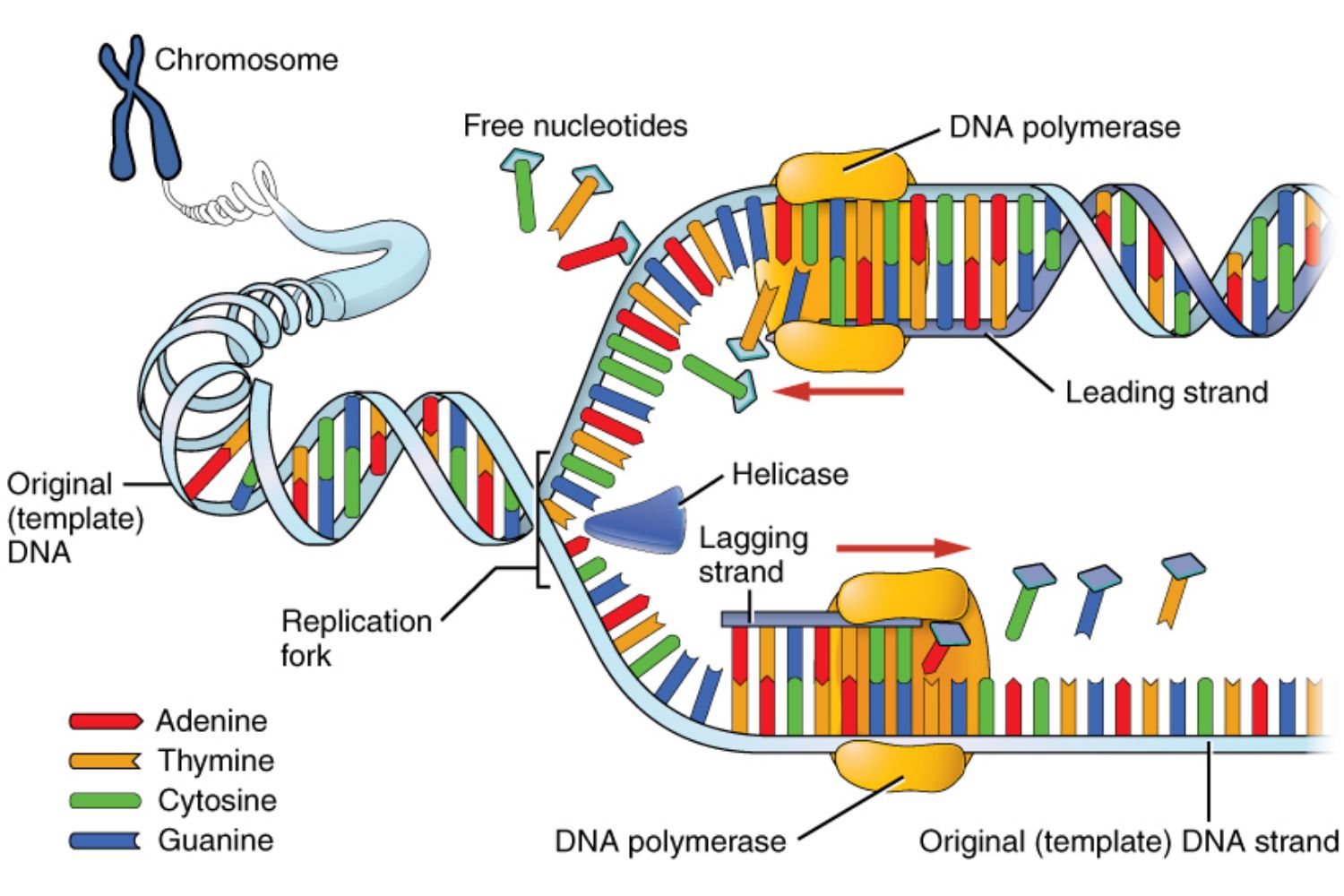Molecule Tutorials - Herong's Tutorial Examples - v1.26, by Herong Yang
Chromosome Replication (or DNA Replication)
This section provides a quick introduction of the Chromosome Replication (or DNA Replication) process, where the double helix DNA structure is forked into two strands to form two new identical two double helix DNA structures.
What Is Chromosome Replication? - Chromosome Replication is the process that all 46 paired chromosomes in a human cell get replicated into 2 sets of identical 46 paired chromosomes. Chromosome Replication occurs when the cell is ready to be divided into 2 identical cells.
During the replication process of a chromosome, the double helix DNA structure hidden inside the chromosome gets replicated into two identical double helix DNA structures. So Chromosome Replication is also called DNA Replication.
Of course, when all 46 paired chromosomes are replicated in human cell, the entire human genome is also replicated into 2 copies.
The DNA replication process in a chromosome can be described as the following steps:
1. Loosening of Chromosome Fibre - As the first step of the DNA replication process, the chromosome fibre loosens and unwinds to expose the double helix DNA structure to give access to cell replication enzymes.
2. Formation of Replication Fork - When the double helix DNA structure is exposed, a special enzyme call DNA helicase comes in to break the hydrogen bonds of base pairs. This step changes the DNA structure into a Y shape known as the replication fork. The two forked branches represents the two complementary strands acting as templates to form 2 new double helix DNA structures.
Because DNA strands are directional from nucleotide residue point of view running running from the 5' end to the 3' end, the two complementary DNA strands separated by the replication fork are actually running opposite directions. The forked strand that runs in the same direction as the forking process is called the leading strand. The other forked strand that runs in the opposite direction as the forking process is called the lagging strand.
3. Binding of RNA Primers - For the leading strand, a short complementary RNA called primer is paired to the beginning of the strand to form the beginning chunk of the new double helix DNA structure.
For the lagging strand, many short complementary RNA primers are paired to the strand with short gaps (only several bases wide) to form separated chunks of the new double helix DNA structure.
RNA primers are generated by special enzymes called DNA primases.
4. Elongation Process - For the leading strand, a special enzyme called DNA polymerase pairs complementary nucleotides continuously one by one from beginning double helix chunk created by the RNA primer to grow the new double helix DNA structure.
For the lagging strand, DNA polymerases pairs complementary DNA pieces called Okazaki fragments into the gaps between double helix chunks created RNA primers to grow the new double helix DNA structure.
5. Termination - Once the Elongation Process is completed on both leading strand and lagging strand, the new formed complementary strands goes through a 4-step termination process.
- Removing RNA primers - A special enzyme called exonuclease removes all RNA primers on both newly formed strands and replaces them with appropriate nucleotides.
- Proofreading - Another exonuclease “proofreads” the newly formed strands to check, remove and replace any errors.
- Joining Okazaki Fragments - A special enzyme called DNA ligase joins Okazaki fragments paired to the lagging strand together to complete the new double helix DNA structure.
- Adding Telomeres - A special enzyme called telomerase catalyzes the synthesis of telomere sequences at the end of newly formed DNA strands as protective caps to prevent chromosomes fusing.
5. Coiling and Packaging - Two original DNA strands and their newly formed complementary strands are coiled into their double helix structures. Then they are packaged back to two identical chromosomes to end the entire DNA replication process.
The picture (source: fthmb.tqn.com) below provides a good illustration of the DNA/chromosome replication process:

Once all 46 paired chromosomes in a cell are replicated, it is ready to start its division process.
Table of Contents
Molecule Names and Identifications
Nucleobase, Nucleoside, Nucleotide, DNA and RNA
Gene Expression - Building Proteins
Genetic Transcription - Creating mRNA
Genetic Translation - Creating Protein
DNA Gene Sequence - Exons and Introns
►Chromosome Replication (or DNA Replication)
ChEMBL Database - European Molecular Biology Laboratory
PubChem Database - National Library of Medicine
INSDC (International Nucleotide Sequence Database Collaboration)
HGNC (HUGO Gene Nomenclature Committee)